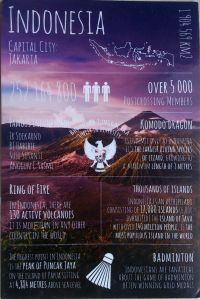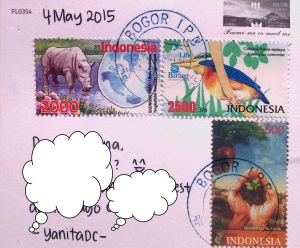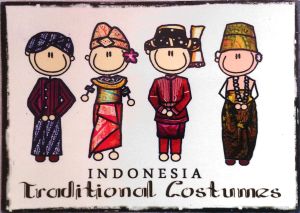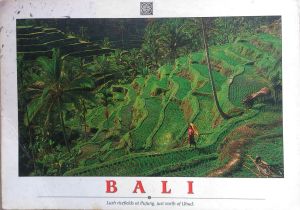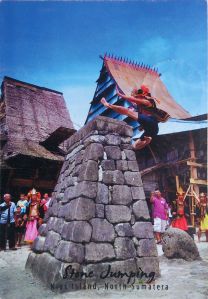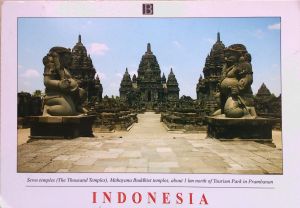From Yanita 🙂
Category Archives: Indonesia
Indonesia: Traditional Costumes
This lovely card comes from Jennifer. 🙂 She says: “We have many races here in Indonesia, each has its own costume, so we have quite a lot of traditional costumes. On the postcard, from left to right, are traditional costumes of: West Java, Bali, Sumatra, and Central Java.”
And here’s my first Postcrossing stamp. 😀
Map of Indonesia
After almost 3 months of waiting, yesterday I finally received this card (along with a few others) from Jennifer from Indonesia. 🙂
Indonesia is a sovereign state in Southeast Asia and Oceania. Indonesia is an archipelago comprising 13,466 islands. The nation’s capital city is Jakarta. Indonesia is a founding member of ASEAN and a member of the G-20 major economies. The Indonesian economy is the world’s 16th largest by nominal GDP. Indonesia consists of hundreds of distinct native ethnic and linguistic groups. The largest – and politically dominant – ethnic group are the Javanese. Indonesia’s national motto, “Bhinneka Tunggal Ika” (“Unity in Diversity” literally, “many, yet one”), articulates the diversity that shapes the country. Despite its large population and densely populated regions, Indonesia has vast areas of wilderness that support the world’s second highest level of biodiversity. The country has abundant natural resources, yet poverty remains widespread.
Balinese tradition
 This one comes from Shella. 🙂 The caption says “Prayers performed as part of a tooth-filing ceremony in Peliatan.”
This one comes from Shella. 🙂 The caption says “Prayers performed as part of a tooth-filing ceremony in Peliatan.”
A tooth filing ceremony is one of the ceremonies that a Balinese must undergo when they come of age. Depending on the finances of the family, they will take place at the onset of puberty or at the latest, when they die. To reduce costs, often families wait till enough children are old enough to have a mass ceremony, rather than having each child done individually.
The ceremony is symbolic essentially of three things: a coming of age, a transition from animal to human represented by the filing of the sharp canines, and the control of the six human evils: desire (kama), greed (lobha), anger (krodha), intoxication or being under the influence of strong emotion (mada), confusion (moha), and jealousy (matsarya).
It is a joyous affair with a lot of colourful offerings and gentle music. The music is played on two gender wayang instruments, particularly suited because of their calming sound and soothing scale. Those present will be family members and invited guests. The people who have their teeth filed are often dressed in fairly ornamental garb with the women donning gold-gilded headdresses.
It takes about ten minutes for each participant to have their teeth filed by the lay priest and is said to be fairly painless. They do however use cloves to numb the mouth slightly. Those not wishing to have their teeth actually physically filed for cosmetic or health reasons may choose to have the ceremony performed only symbolically.
The ceremony, in typically Balinese style, is completed by a buffet of spicy food, sliced fruit and strong coffee or sweet tea.
Bali
This card comes from Irien 🙂
Bali is an island and the smallest province of Indonesia, and includes a few smaller neighbouring islands, notably Nusa Penida. It is located at the westernmost end of the Lesser Sunda Islands, between Java to the west and Lombok to the east, and has its capital of Denpasar at the southern part of the island. With a population of 4.22 million, the island is home to most of Indonesia’s Hindu minority. Bali is also the largest tourist destination in the country and is renowned for its highly developed arts, including traditional and modern dance, sculpture, painting, leather, metalworking, and music. A tourist haven for decades, the province has seen a further surge in tourist numbers in recent years.
Stone Jumping
This postcard comes from Klulan as a “Thank you” for helping him with his homework. 😀
Before Bawomataluo, a city on the island of Nias became a hotbed for tourist activity and Western backpackers, the stone jump was a ritual taken very seriously. Boys leapt to their adulthood, dressed in warrior garb, signifying that they were ready to fight and assume the responsibilities of men. Leaping the stone barrier, ranging in height from 1.5-2 meters, was essentially a final task in warrior training. There is even some historical indication that sharpened bamboo was placed atop the barrier to increase the stakes of the jump.
Today, the jump is still taken seriously and many boys begin training at a young age. However, it has also become a serious spectacle for gawking tourists that want to see traditional rites of another culture. Along with the stone jump, the traditional war dance on the island similarly draws in the gazes of visiting Westerners.
Sunset at Borobudur, vol. 2
Or is it sunrise? Anyway… This absolutely gorgeous cards, one of my all time favorites, comes from Maya. 🙂 That’s my second view card from Borobodur – it looks like a really magical place and I hope that one day I’ll have the chance to see it in person. 🙂
Sewu temples
My second Indonesia card comes from Anis. 🙂
Sewu Temple is an 8th-century Buddhist temple, it is also the second largest Buddhist Temple complex in Java after Borobudur. Although originally only around 249 temples are present, the name in Javanese translates to ‘a thousand temples,’ which originated from popular local folklore – The Legend of Loro Jonggrang. The original name of this temple compound is probably Manjusrigrha.
Sunset at Borobudur
Borobudur is a Buddhist stupa and temple complex in Central Java, Indonesia dating from the 8th century, and a UNESCO World Heritage Site. This is one of world’s truly great ancient monuments, the single largest Buddhist structure anywhere on earth.
There is no definite written record of who built Borobudur or why it was built. It was likely founded as a religious site in the 8th century at the peak of the Sailendra dynasty in central Java. The construction is thought to have taken a period of 75 years, and completed in about 825 A.D.
This card came from Erin from Singapore who was travelling in Indonesia. 🙂
